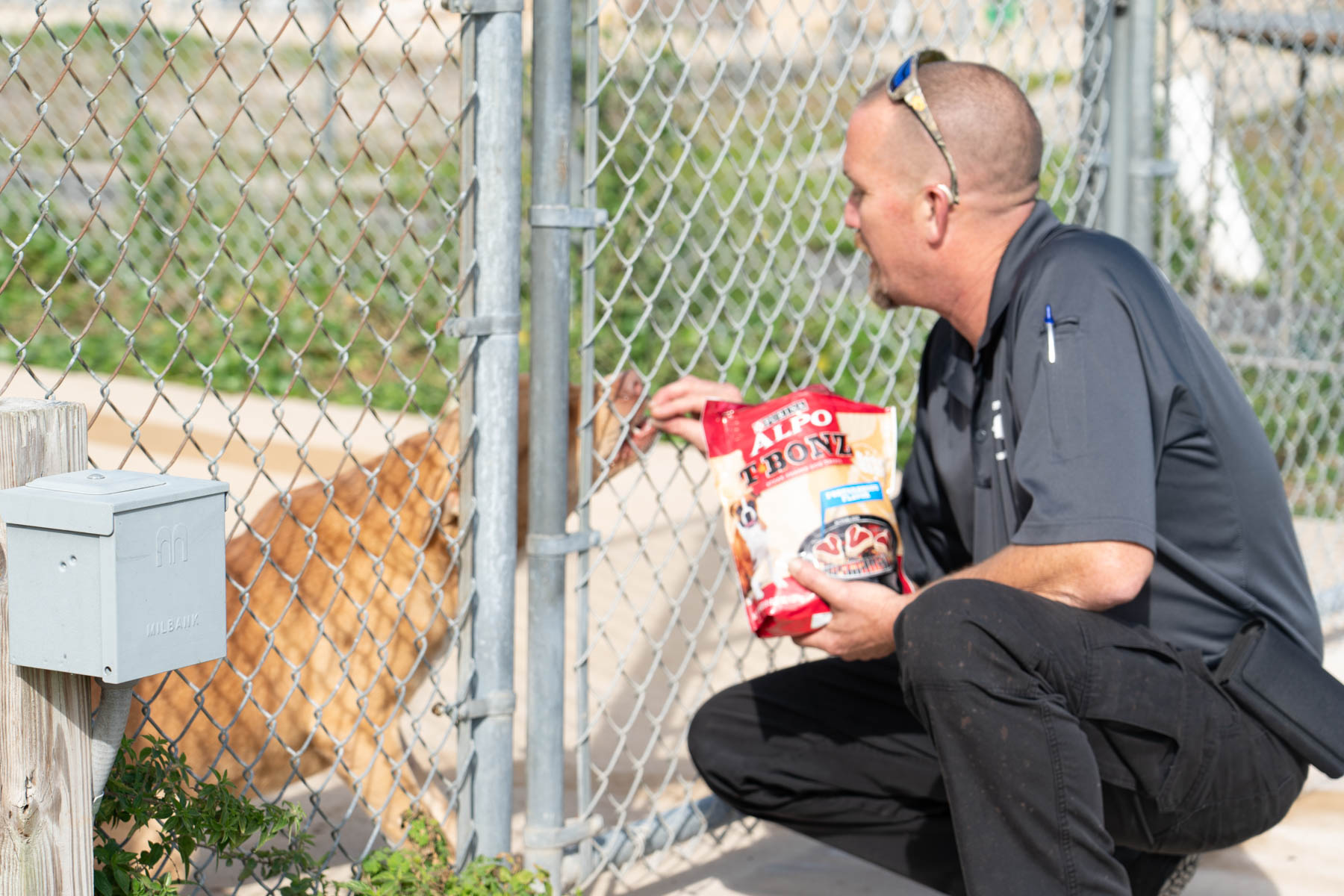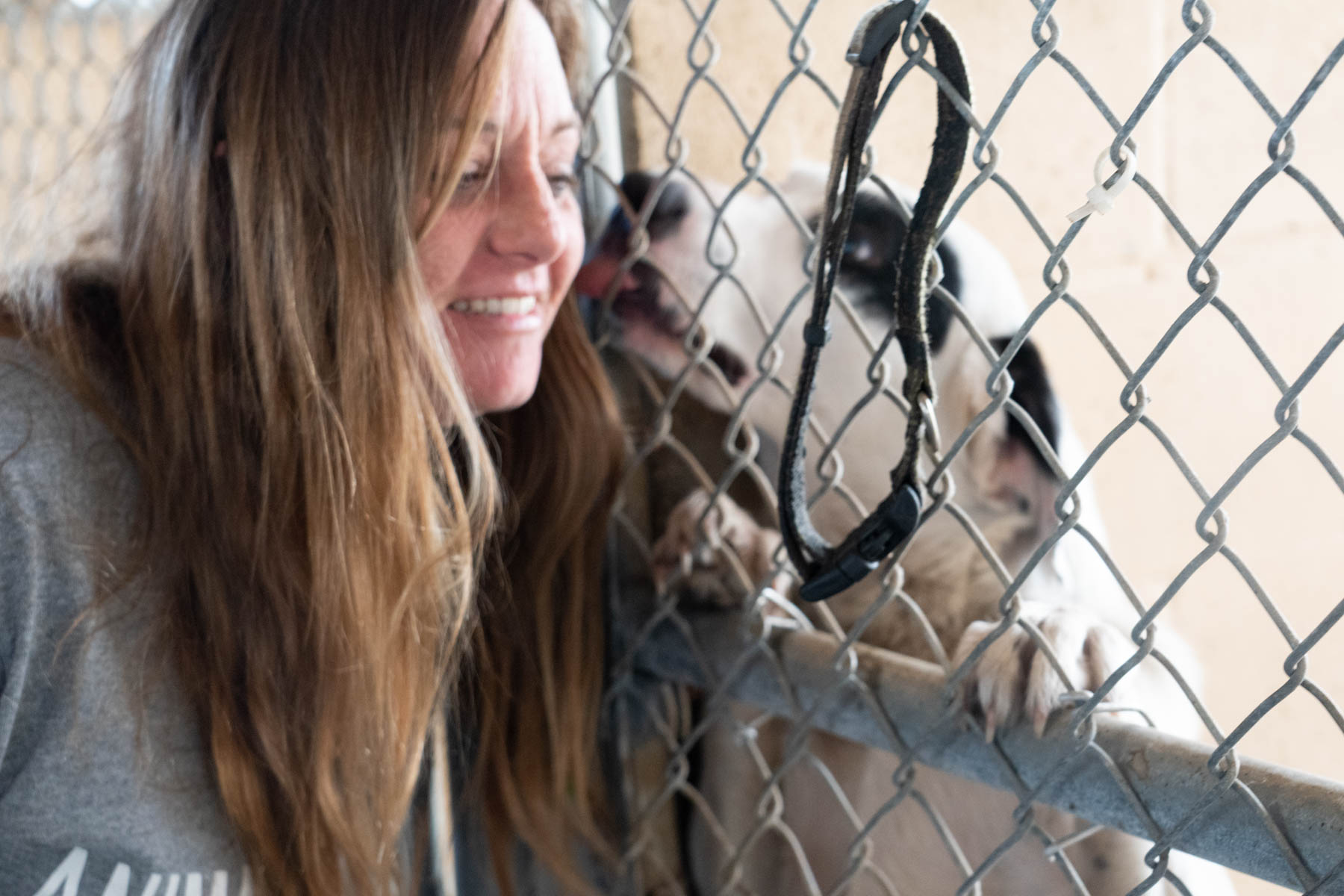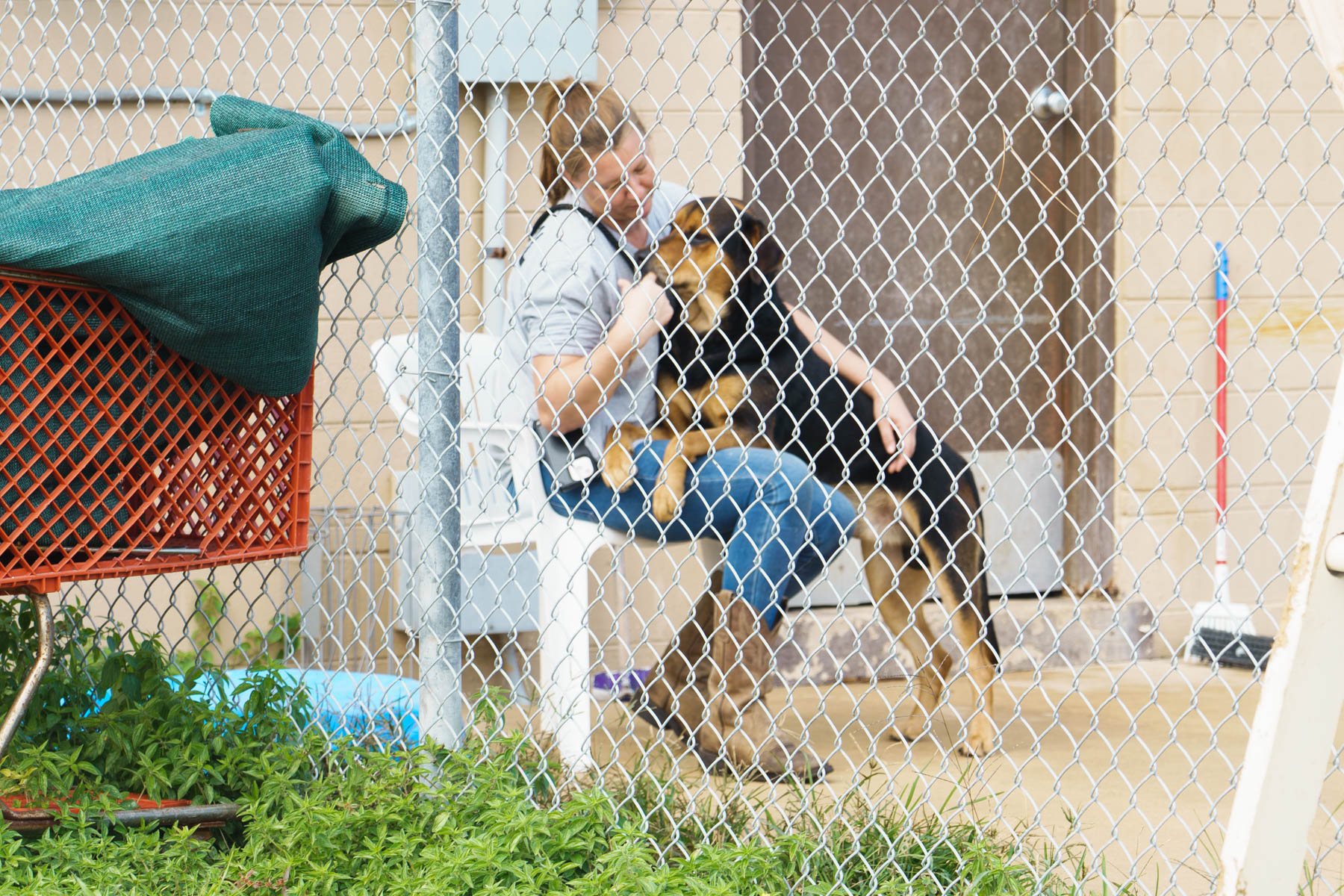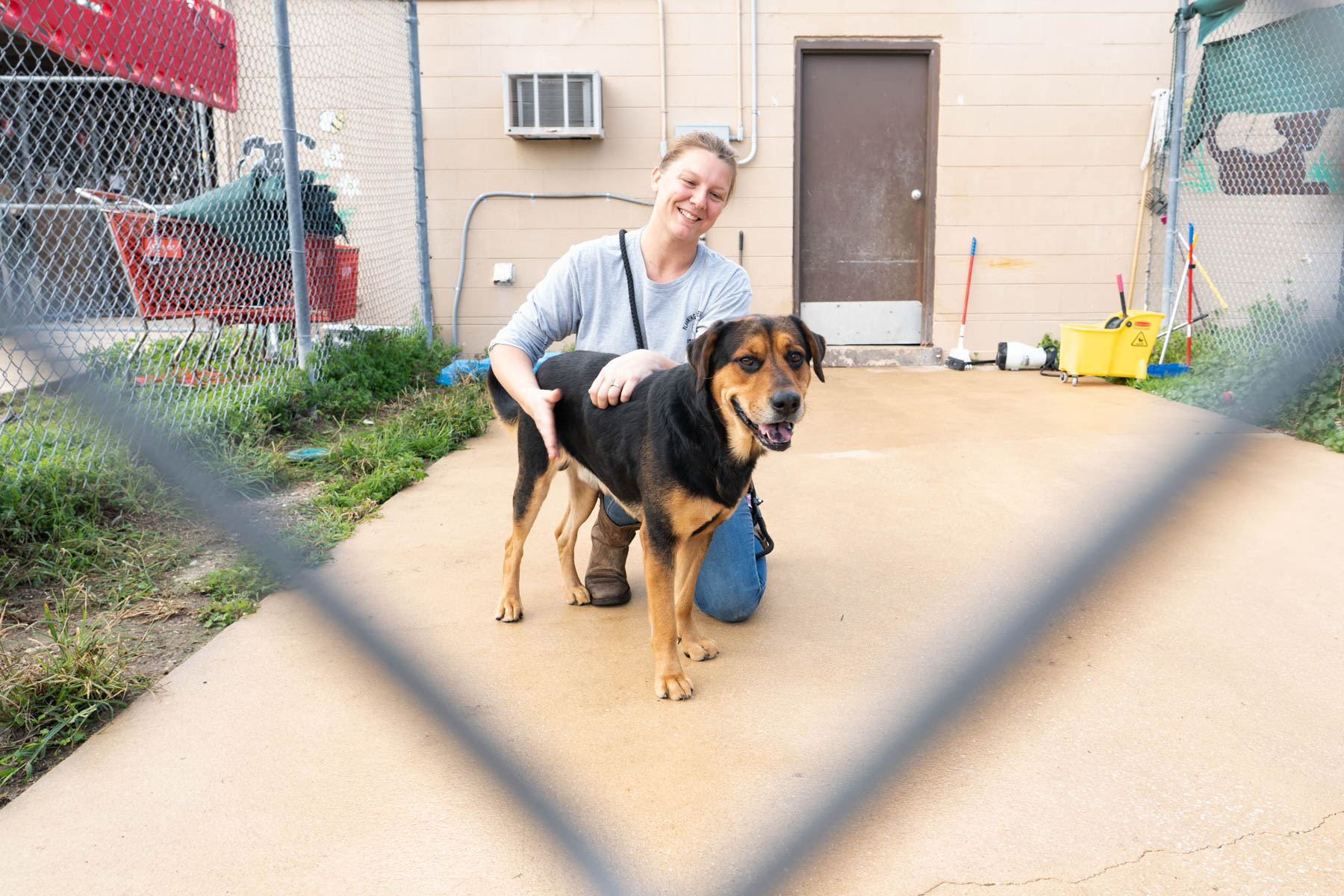At the end of the long sandy road that takes you around the landfill, past the public works sheds, there is a collection of buildings that are the home of the Putnam County Animal Control. (For now…).





We were greeted by a chorus of barking (there were over 50 dogs in residence for our visit) and Pookey, the director of PCAC, whose warm smile radiated a positive energy.
Pookey first got involved with the shelter, advocating for the animals from home. Soon, though, she and her sister came to the shelter to volunteer. That was probably 12 years ago. Like so many others, the animals slowly took over her soul. She went from volunteer to kennel tech to Animal Control Officer to now Supervisor. She’s worked fulltime for the shelter for six years.

“You’ll have to bury me with the building,” she says with a laugh. Pookey is even here on days off and holidays, doing pretty much everything. She’ll scoop poop and feed animals, but she’ll also run animal control calls. She networks all the dogs to an impressive list of partner rescues, depending on those partners to save lives.
Putnam County is a ‘kill facility that doesn’t kill,” she says. Which means that while they are Animal Control and have a finite number of kennel slots and budget, and technically they should be killing animals that aren’t reclaimed, they manage to not kill any animals (they do euthanize severe medical or behavioral cases) through reclaims, local adoptions, and that vast network of rescues.
Pookey and the shelter team hold adoption events and get help from Ana’s Angels Animal Rescue, a rescue group in Jacksonville, who will take their animals and showcase them at adoption events, get many adopted and return the ones they don’t.
You can see all the adoptable animals at Furry Adoptables of Putnam. The shelter does have a couple volunteers but wishes they had more. They could use the help, but Pookey understands that a lot of people don’t want to drive out to the landfill. She’s hopeful when they have a new building, things will be different and the community will be more involved.
The money and the space (next to the Sheriff’s office five miles away) are ready, so hopefully their long wait will soon be over. New buildings in places with better public accessibility and visibility do usually help shelters, but too often a bigger building only means more animals. The most important changes will happen if the public not only sees the building (and the animals) but gets invested in the work there—becoming a partner in solving the problem of too many unwanted dogs via funding, accountability, access to spay/neuter, smart animal laws, compassionate care, foster homes, and a robust volunteer program.
Over the cacophony of barking, Pookey told us about her dogs. We listened to the hard luck stories, the cruelty cases, dogs left alone at empty houses after owners move away or die, and tales of dogs dumped at the entrance to the landfill on Christmas day.




The shelter requires that people make an appointment to surrender their dog and often they have to wait 2-3 weeks. This gives them time to reconsider or grow impatient and rehome the dog themselves. Either outcome helps. But there are the people who simply pull up the road and let their dogs out. Those dogs come into the facility as confused and terrified strays.
I asked the question I ask everyone I meet in sheltering – why do you think the problem continues? Pookey thought for a minute and said, “Irresponsible people.”
She then added that more spay and neuter would really help. To that end the shelter received a 20K grant to get community animals spayed and neutered. The shelter animals themselves are usually spayed/neutered by University of Florida veterinary students. That’s also where they are vaccinated, microchipped, and tested for heartworm (although the shelter, like so many others, doesn’t have the budget to give heartworm preventative to their population).
We watched a gorgeous chocolate lab mix named Tundra playing in the small cement play yard. Tundra has been there almost a year and has come a long way. From the sounds of it, he was nearly feral when he arrived, but slowly with care, he is getting braver. We watched as he played with one of the ACO’s and he reminded me of my timid dog at home. You wonder what they have been through to make them so incredibly fearful.

Bonnie, one of the Animal Control Officers, has been working at the shelter for three years. The day we visited she was doubling as a kennel tech, cleaning kennels because the shelter has only one kennel tech at the moment (and two open positions).
Bonnie used to be a dental hygienist but loves her work at the shelter. She said, “It’s never the same; there’s something different to do every day. And when you see the dogs get homes, it’s the best success ever.” She said it is hard when you can’t save one, but the good outweighs the bad. All of the staff we met we positive and friendly and seemed to have a great repertoire with each other.




As we walked through the multiple buildings, I handed out every treat I had, while Nancy snapped pictures. The dogs were loud and stressed—the facility is older and has the traditional dog pound set up of kennels facing each other. Our presence stirred them up. Some settled and licked my hands when I crouched in front of their kennels, while others leapt in the air trying to get our attention, and a few retreated to the back of their kennels, tails tucked.










The shelter has one volunteer who comes and walk the dogs, but they could use more help so the dogs could get more exercise. Hopefully, with the new building both of those issues will get better. They do have a little open area around the kennels, so I suggested they look into Dogs Playing For Life. Playgroups go a long way toward easing the mental and emotional stress of dogs living in shelters.
The staff at the shelter clearly love and know these dogs. While the accommodations might be tough, the innkeepers are kind and doing the most they can with what they’ve got. The county government is behind the shelter’s work and values it. And even in this very rural county, they come together to support the shelter. One of the towns (Interlochen) gives the shelter ten thousand dollars every year.
I wondered as we drove away—how do we help this situation? We gave them the last of the donations we had with us. I wish we’d had more—maybe bully sticks, Kongs, or benebones or something to occupy so many busy minds and jaws. It was nearly 70 degrees while we were there, and I could only imagine how hot it must be for these dogs in the summer with only fans and baby pools for relief.
The sounds of the frantic barking echoed in my head driving south to our next visit. I wish it were different. I wish it wasn’t the way it is. I pray each of those dogs finds a home where it has a soft place to sleep, a yard to run in, and a family to love it. I’m hopeful that the new building will make things better, but I also wonder if that building will just fill up too.
We must do better. Dogs deserve better. I’m grateful for the work of Pookey and Bonnie and the others at Putnam County Animal Control. They stayed on my heart as we went on to visit three large private rescues where the accommodations were much cushier.

I continue to ache at the incongruous situation—why public sheltering is such a struggle while just own the road, private shelters offer first-class accommodations, training, enrichment, and medical care.; while rescues scramble to help the dogs that fall in the gap. And why even after all these years and all these best efforts, we haven’t found a way to join forces so that when a dog finds itself homeless, it can at least receive comfortable, appropriate, compassionate care until a home is found. It doesn’t seem like such a tall bill to me. Having visited nearly 80 shelters and rescues now, I know it’s possible. And what’s more –it’s not that difficult or expensive.
If you’d like to help Putnam County Animal Control, consider purchasing something from their Amazon Wishlist: https://www.amazon.com/gp/registry/wishlist/378PUMZFKJYM9/

Until each one has a home,
Cara
Please help us raise awareness by subscribing (button on right side) and sharing this blog. You can also keep track of us on Facebook, Instagram, YouTube, and now Tik Tok!
The mission of Who Will Let the Dogs Out (we call it Waldo for short) is to raise awareness and resources for homeless dogs and the heroes who fight for them.
You can learn more about what is happening in our southern shelters and rescues in the book, One Hundred Dogs & Counting: One Woman, Ten Thousand Miles, and a Journey Into the Heart of Shelters and Rescues (Pegasus Books, 2020). It’s the story of a challenging foster dog who inspired me to travel south to find out where all the dogs were coming from. It tells the story of how Who Will Let the Dogs Out began. Find it anywhere books are sold. A portion of the proceeds of every book sold go to help unwanted animals in the south.

Amber’s Halfway Home is our short documentary film produced in partnership with Farnival Films. It follows the work of a remarkable woman and one day of rescue in western Tennessee. Selected for sixteen film festivals (to date), it’s won eight awards (including Best Short Doc, Best Soundtrack, Best of Fest, and Audience Choice), and was nominated for an Emmy! It is a beautiful, heartbreaking, inspiring story we hope will compel viewers to work for change. Please watch it and share it far and wide.
For more information on any of our projects, to talk about rescue in your neck of the woods, or become a Waldo volunteer, please email whowillletthedogsout@gmail.com or carasueachterberg@gmail.com.



Naomi Johnson
Again, the only way to stop this tragic situation of pet overpopulation is at the intake end. The South needs to pass licensing laws for dogs–spayed and neutered pets $10-15/year and $75-100 for intact animals, plus stiff fines for abandoning or not caring for their pets. Once it hits the owners’ pocketbooks, they will will be more responsible of their pets. The revenue generated from the licenses will go towards better accommodations at shelters and officers to see that pets are licensed. That’s the way things changed in the North. Before licensing laws in the North, things were not much different.
Lisa Kane DeVitto
Absolutely. We can’t adopt our way out of overpopulation. Owners need to be responsible.
michael
I am trying to send them stuff thru their amazon wishlist but when I check out it tries to ship it to me because they do not have an address or name listed on their list. Help so I can get them donations please.
Melissa
174 County Landfill Rd, Palatka, FL 32177
Michael
Like I have said before up above, I am trying to send them some stuff via amazon. No one will answer my comment and I also tried to email the author of this article. I would really like to help out here.